Unraveling the Nature of Hydrogen Bonds of “Proton Sponges” Based on Car-Parrinello and Metadynamics Approaches
Abstract
1. Introduction
- (i)
- What is the mechanism of proton motion in an intramolecular N-H⋯N bond in symmetric/asymmetric “proton sponges”?
- (ii)
- Does the proton transfer play a determinant role in changing the physico-chemical features in selected “proton sponges”?
- (iii)
- What is the environmental impact on the intramolecular hydrogen bond features?
- (iv)
- What is the temperature impact on the dynamics of the intramolecular hydrogen bond?
2. Results and Discussion
2.1. Hirshfeld Surface Analysis
2.2. Car–Parrinello Molecular Dynamics (CPMD) in the Gas and Crystalline Phases
2.3. Path Integral Molecular Dynamics—Inclusion of Nuclear Quantum Effects
2.4. Metadynamics
2.5. Static Density Functional Theory (DFT)
3. Materials and Methods
4. Conclusions
- The Hirshfeld Surface (HS) and fingerprint data show intra- and intermolecular interactions in the crystals of the studied “proton sponges”.
- Car–Parrinello Molecular Dynamics results enabled the time-evolution analysis of the bridged proton in the intramolecular hydrogen bond. The proton is very labile, and its movement is governed by a double-well potential, which can be asymmetric. The broken symmetry in the symmetric “proton sponges” can have internal origin (not enough energy to cross the barriers-vanishing at 300 K) or external cause (asymmetry of the crystal environment). For the asymmetric compounds (3) and (4), the intramolecular factor is more important than the environment. Quantum effects reproduced via the PIMD approach lead to significant broadening of the bridge proton probability distribution.
- Metadynamics has allowed us to estimate the depths of free energy wells, ranging from −17.7 to −34 kcal/mol. This biased molecular dynamics scheme has proven successful in investigating the double-well free energy surface, but the proton remained within the space between the two nitrogen atoms.
- QTAIM studies showed that the stronger H⋯N interactions are covalent in the investigated compounds (1)–(3), while the weaker contacts exhibit only subtle covalency. A different situation is observed for compound (4) with the supremacy of the H⋯N interactions with the proton directed to the “donor” nitrogen atom of the amine group of the substituted ring.
- DORI molecular plots revealed regions indicating the presence of covalent and non-covalent interactions for compound (4) at 100 K with simulation times of 0 and 24 ps.
Supplementary Materials
Author Contributions
Funding
Institutional Review Board Statement
Informed Consent Statement
Data Availability Statement
Acknowledgments
Conflicts of Interest
Abbreviations
| BCP | Bond Critical Point |
| CPMD | Car–Parrinello Molecular Dynamics |
| CVs | Collective Variables |
| DFT | Density Functional Theory |
| DORI | Density Overlap Regions Indicator |
| HB | Hydrogen Bond |
| IR | Infrared Spectroscopy |
| LBHB | Low-Barrier Hydrogen Bond |
| MD | Molecular Dynamics |
| NCI | Non-covalent Interactions Index |
| NMR | Nuclear magnetic resonance |
| PIMD | Path Integrals Molecular Dynamics |
| PT | Proton transfer |
| QTAIM | Quantum Theory of Atoms in Molecules |
| RCP | Ring Critical Point |
| RDG | Reduced Density Gradient |
| VDW | van der Waals |
References
- Rapaport, D. The Art of Molecular Dynamics Simulation; Cambridge University Press: Cambridge, UK, 2011. [Google Scholar] [CrossRef]
- Car, R.; Parrinello, M. Unified Approach for Molecular Dynamics and Density-Functional Theory. Phys. Rev. Lett. 1985, 55, 2471–2474. [Google Scholar] [CrossRef] [PubMed]
- Svishchev, I.M.; Kusalik, P.G. Crystallization of Liquid Water in a Molecular Dynamics Simulation. Phys. Rev. Lett. 1994, 73, 975–978. [Google Scholar] [CrossRef]
- Head-Gordon, M.; Tully, J.C. Molecular dynamics with electronic frictions. J. Chem. Phys. 1995, 103, 10137–10145. [Google Scholar] [CrossRef]
- Marx, D.; Parrinello, M. The Effect of Quantum and Thermal Fluctuations on the Structure of the Floppy Molecule C2H3+. Science 1996, 271, 179–181. [Google Scholar] [CrossRef]
- Tuckerman, M.E.; Marx, D.; Klein, M.L.; Parrinello, M. Efficient and general algorithms for path integral Car–Parrinello molecular dynamics. J. Chem. Phys. 1996, 104, 5579–5588. [Google Scholar] [CrossRef]
- Tuckerman, M.E.; Marx, D.; Klein, M.L.; Parrinello, M. On the Quantum Nature of the Shared Proton in Hydrogen Bonds. Science 1997, 275, 817–820. [Google Scholar] [CrossRef]
- Frank, I.; Hutter, J.; Marx, D.; Parrinello, M. Molecular dynamics in low-spin excited states. J. Chem. Phys. 1998, 108, 4060–4069. [Google Scholar] [CrossRef]
- Tuckerman, M.E.; Marx, D. Heavy-Atom Skeleton Quantization and Proton Tunneling in “Intermediate-Barrier” Hydrogen Bonds. Phys. Rev. Lett. 2001, 86, 4946–4949. [Google Scholar] [CrossRef]
- Carloni, P.; Rothlisberger, U.; Parrinello, M. The Role and Perspective of Ab Initio Molecular Dynamics in the Study of Biological Systems. Acc. Chem. Res. 2002, 35, 455–464. [Google Scholar] [CrossRef]
- Doltsinis, N.L.; Marx, D. Nonadiabatic Car–Parrinello Molecular Dynamics. Phys. Rev. Lett. 2002, 88, 166402. [Google Scholar] [CrossRef]
- Scherlis, D.A.; Fattebert, J.L.; Gygi, F.; Cococcioni, M.; Marzari, N. A unified electrostatic and cavitation model for first-principles molecular dynamics in solution. J. Chem. Phys. 2006, 124, 074103. [Google Scholar] [CrossRef] [PubMed]
- Berkelbach, T.C.; Lee, H.S.; Tuckerman, M.E. Concerted Hydrogen-Bond Dynamics in the Transport Mechanism of the Hydrated Proton: A First-Principles Molecular Dynamics Study. Phys. Rev. Lett. 2009, 103, 238302. [Google Scholar] [CrossRef] [PubMed]
- Curchod, B.F.E.; Martínez, T.J. Ab Initio Nonadiabatic Quantum Molecular Dynamics. Chem. Rev. 2018, 118, 3305–3336. [Google Scholar] [CrossRef] [PubMed]
- Maginn, E.J.; Elliott, J.R. Historical Perspective and Current Outlook for Molecular Dynamics As a Chemical Engineering Tool. Ind. Eng. Chem. Res. 2010, 49, 3059–3078. [Google Scholar] [CrossRef]
- Matthews, B.L.C. Molecular Dynamics: With Deterministic and Stochastic Numerical Methods; Springer International Publishing: Berlin/Heidelberg, Germany, 2015. [Google Scholar]
- Alabugin, I.V.; Gilmore, K.M.; Peterson, P.W. Hyperconjugation. WIREs Comput. Mol. Sci. 2011, 1, 109–141. [Google Scholar] [CrossRef]
- Marx, D.; Hütter, J. Ab Initio Molecular Dynamics: Theory and Implementation in Modern Methods and Algorithms of Quantum Chemistry; Grotendorst, J., Ed.; NIC Series; John von Neumann Institute for Computing: Jülich, Germany, 2000. [Google Scholar]
- Fois, E.; Gamba, A. Dynamical Host/Guest Interactions in Zeolites: Framework Isotope Effects on Proton Transfer Studied by Car–Parrinello Molecular Dynamics. J. Phys. Chem. B 1999, 103, 1794–1799. [Google Scholar] [CrossRef]
- Boero, M.; Terakura, K.; Ikeshoji, T.; Liew, C.C.; Parrinello, M. Hydrogen Bonding and Dipole Moment of Water at Supercritical Conditions: A First-Principles Molecular Dynamics Study. Phys. Rev. Lett. 2000, 85, 3245–3248. [Google Scholar] [CrossRef] [PubMed]
- Stirling, A.; Bernasconi, M.; Parrinello, M. Ab initio simulation of water interaction with the (100) surface of pyrite. J. Chem. Phys. 2003, 118, 8917–8926. [Google Scholar] [CrossRef]
- Costanzo, F.; Valle, R.G.D. Car–Parrinello MD Simulations for the Na+-Phenylalanine Complex in Aqueous Solution. J. Phys. Chem. B 2008, 112, 12783–12789. [Google Scholar] [CrossRef]
- Jezierska, A.; Panek, J.J. Investigations of an O-H⋯S hydrogen bond via Car–Parrinello and path integral molecular dynamics. J. Comput. Chem. 2008, 30, 1241–1250. [Google Scholar] [CrossRef]
- Durlak, P.; Latajka, Z. Car–Parrinello and path integral molecular dynamics study of the intramolecular hydrogen bond in the novel class of anionic H-chelates: 6-Nitro-2, 3-dipyrrol-2-ylquinoxaline anion. Chem. Phys. Lett. 2009, 480, 173–177. [Google Scholar] [CrossRef]
- Shishkin, O.V.; Dopieralski, P.; Omelchenko, I.V.; Gorb, L.; Latajka, Z.; Leszczynski, J. Dynamical Nonplanarity of Benzene. Evidences from the Car–Parrinello Molecular Dynamics Study. J. Phys. Chem. Lett. 2011, 2, 2881–2884. [Google Scholar] [CrossRef]
- Dopieralski, P.; Perrin, C.L.; Latajka, Z. On the Intramolecular Hydrogen Bond in Solution: Car–Parrinello and Path Integral Molecular Dynamics Perspective. J. Chem. Theory Comput. 2011, 7, 3505–3513. [Google Scholar] [CrossRef] [PubMed]
- Jezierska, A.; Panek, J.J. “Zwitterionic Proton Sponge” Hydrogen Bonding Investigations on the Basis of Car–Parrinello Molecular Dynamics. J. Chem. Inf. Model. 2015, 55, 1148–1157. [Google Scholar] [CrossRef] [PubMed]
- Durlak, P.; Latajka, Z. Car–Parrinello and Path Integral Molecular Dynamics Study of the Proton Transfer in the Intramolecular Hydrogen Bonds in the Ketohydrazone–Azoenol System. J. Phys. Chem. B 2018, 122, 7862–7873. [Google Scholar] [CrossRef]
- Jezierska, A.; Panek, J.J. Theoretical study of intramolecular hydrogen bond in selected symmetric “proton sponges” on the basis of DFT and CPMD methods. J. Mol. Model. 2020, 26, 2–10. [Google Scholar] [CrossRef]
- Panek, J.J.; Zasada, J.; Szyja, B.M.; Kizior, B.; Jezierska, A. Sensitivity of Intra- and Intermolecular Interactions of Benzo[h]quinoline from Car–Parrinello Molecular Dynamics and Electronic Structure Inspection. Int. J. Mol. Sci. 2021, 22, 5220. [Google Scholar] [CrossRef]
- Kizior, B.; Panek, J.J.; Szyja, B.M.; Jezierska, A. Structure-Property Relationship in Selected Naphtho- and Anthra-Quinone Derivatives on the Basis of Density Functional Theory and Car–Parrinello Molecular Dynamics. Symmetry 2021, 13, 564. [Google Scholar] [CrossRef]
- Müller-Dethlefs, K.; Hobza, P. Noncovalent Interactions: A Challenge for Experiment and Theory. Chem. Rev. 2000, 100, 143–168. [Google Scholar] [CrossRef]
- Scheiner, S. Hydrogen Bonding; Oxford University Press: Oxford, UK, 1997. [Google Scholar]
- Hobza, P.; Zahradník, R.; Müller-Dethlefs, K. The World of Non-Covalent Interactions: 2006. Collect. Czechoslov. Chem. Commun. 2006, 71, 443–531. [Google Scholar] [CrossRef]
- Feynman, R.P. Space-Time Approach to Non-Relativistic Quantum Mechanics. Rev. Mod. Phys. 1948, 20, 367–387. [Google Scholar] [CrossRef]
- Jezierska-Mazzarello, A.; Vuilleumier, R.; Panek, J.J.; Ciccotti, G. Molecular Property Investigations of an ortho-Hydroxy Schiff Base Type Compound with the First-Principle Molecular Dynamics Approach. J. Phys. Chem. B 2009, 114, 242–253. [Google Scholar] [CrossRef] [PubMed]
- Wojtkowiak, K.; Michalczyk, M.; Zierkiewicz, W.; Jezierska, A.; Panek, J.J. Chalcogen Bond as a Factor Stabilizing Ligand Conformation in the Binding Pocket of Carbonic Anhydrase IX Receptor Mimic. Int. J. Mol. Sci. 2022, 23, 13701. [Google Scholar] [CrossRef] [PubMed]
- Jezierska, A.; Kizior, B.; Szyja, B.M.; Panek, J.J. On the nature of inter- and intramolecular interactions involving benzo[h]quinoline and 10-hydroxybenzo[h]quinoline: Electronic ground state vs excited state study. J. Mol. Struct. 2021, 1234, 130126. [Google Scholar] [CrossRef]
- Simón, L.; Goodman, J.M. Enzyme Catalysis by Hydrogen Bonds: The Balance between Transition State Binding and Substrate Binding in Oxyanion Holes. J. Org. Chem. 2010, 75, 1831–1840. [Google Scholar] [CrossRef]
- Abeln, S.; Vendruscolo, M.; Dobson, C.M.; Frenkel, D. A Simple Lattice Model That Captures Protein Folding, Aggregation and Amyloid Formation. PLoS ONE 2014, 9, e85185. [Google Scholar] [CrossRef]
- Wieczorek, R.; Dannenberg, J.J. H-Bonding Cooperativity and Energetics of α-Helix Formation of Five 17-Amino Acid Peptides. J. Am. Chem. Soc. 2003, 125, 8124–8129. [Google Scholar] [CrossRef]
- Jezierska-Mazzarello, A.; Panek, J.J.; Szatyłowicz, H.; Krygowski, T.M. Hydrogen Bonding as a Modulator of Aromaticity and Electronic Structure of Selected ortho-Hydroxybenzaldehyde Derivatives. J. Phys. Chem. A 2012, 116, 460–475. [Google Scholar] [CrossRef]
- Pocheć, M.; Kułacz, K.; Panek, J.J.; Jezierska, A. How Substitution Combines with Non-Covalent Interactions to Modulate 1, 4-Naphthoquinone and Its Derivatives Molecular Features—Multifactor Studies. Int. J. Mol. Sci. 2021, 22, 10357. [Google Scholar] [CrossRef]
- Zeng, Y.; Li, A.; Yan, T. Hydrogen Bond Dynamics in the Solvation Shell on Proton Transfer in Aqueous Solution. J. Phys. Chem. B 2020, 124, 1817–1823. [Google Scholar] [CrossRef]
- Durlak, P.; Latajka, Z. Proton transfer dynamics in the propionic acid dimer from path integral molecular dynamics calculations. J. Mol. Model. 2011, 17, 2159–2168. [Google Scholar] [CrossRef] [PubMed]
- Pullanchery, S.; Kulik, S.; Rehl, B.; Hassanali, A.; Roke, S. Charge transfer across C–H⋯O hydrogen bonds stabilizes oil droplets in water. Science 2021, 374, 1366–1370. [Google Scholar] [CrossRef] [PubMed]
- Kanters, J.A.; ter Horst, E.H.; Kroon, J.; Grech, E. Complexes of the ’proton sponge’ 1, 8-bis(dimethylamino)naphthalene (DMAN). III. Structure of [DMANH]+.[pentachlorophenolate]−.[pentachlorophenol]2 at 100 K. Acta Crystallogr. C Struct. Chem. 1992, C48, 328–332. [Google Scholar] [CrossRef]
- Staab, H.A.; Kriege, C.; Hieber, G.; Oberdorf, K. 1,8-Bis(dimethylamino)4, 5-dihydroxynaphthalene, a Natural, Intramolecularly Protonated“Proton Sponge” with Zwitterionic Structure. Angew. Chem. Int. Ed. EngI. 1997, 36, 1884–1886. [Google Scholar] [CrossRef]
- Ozeryanskii, V.; Pozharskii, A.; Głowiak, T.; Majerz, I.; Sobczyk, L.; Grech, E.; Nowicka-Scheibe, J. X-ray diffraction and IR-spectroscopic studies on protonated 4-amino-1, 8-bis(dimethylamino)naphthalene. J. Mol. Struct. 2002, 607, 1–8. [Google Scholar] [CrossRef]
- Pozharskii, A.F.; Kuźmenko, V.V.; Aleksandrov, G.G.; Dmitrienko, D.V. 1,8-Bis(dimethylamino)naphthalene. XIII. Solvatochromism and molecular structure of 4-nitro-1,8-bis(dimethylamino)naphthalene and its salt with perchloric acid. Zhurnal Organicheskoi Khimii 1995, 31, 570. [Google Scholar]
- Alder, R.W.; Bowman, P.S.; Steele, W.R.S.; Winterman, D.R. The remarkable basicity of 1, 8-bis(dimethylamino)naphthalene. Chem. Commun. 1968, 13, 723–724. [Google Scholar] [CrossRef]
- Bakshi, P.K.; Cameron, T.S.; Knop, O. Crystal chemistry of tetraradial species. Part 8. Mix and match: Cation geometry, ion packing, hydrogen bonding, and π–π interactions in cis-2, 2′-bipyridinium(1+) and 1, 10-phenanthrolinium(1+) tetraphenylborates—and what about proton sponges? Can. J. Chem. 1996, 74, 201–220. [Google Scholar] [CrossRef]
- Pyżalska, D.; Pyżalski, R.; Borowiak, T. Structure of 1, 8-bis(dimethylamino)naphthalene hydrobromide dihydrate. J. Crystallogr. Spectrosc. Res. 1983, 13, 211–220. [Google Scholar] [CrossRef]
- Woźniak, K.; Krygowski, T.; Kariuki, B.; Jones, W.; Grech, E. Crystallographic studies on sterically affected chemical species Part II. Molecular and crystal structure of 1, 8-bis(dimethylamino)- naphthalene tetrafluoroborate. Analysis of distortion of geometry in the aromatic part due to intramolecular hydrogen bonding. J. Mol. Struct. 1990, 240, 111–118. [Google Scholar] [CrossRef]
- Kellett, P.J.; Anderson, O.P.; Strauss, S.H.; Abney, K.D. Solid-state motion of OTeF5− compounds: Detection by 19F NMR and IR spectroscopy and correlation with the X-ray structure of an orthorhombic crystalline modification of [C14H19N2+][OTeF5−] (C14H19N2+ = protonated 1, 8-bis(dimethylamino)naphthalene). Can. J. Chem. 1989, 67, 2023–2029. [Google Scholar] [CrossRef]
- Bartoszak, E.; Dega-Szafran, Z.; Grundwald-Wyspiańska, M.; Jaskólski, M.; Szafran, M. X-ray, Fourier-transform infrared, 1H and 13C nuclear magnetic resonance, and PM3 studies of (N—H⋯N)+ and (O—H⋯O)− intramolecular hydrogen bonds in a complex of 1, 8-bis(dimethylamino)naphthalene with maleic acid. J. Chem. Soc., Faraday Trans. 1993, 89, 2085–2094. [Google Scholar] [CrossRef]
- Bartoszak, E.; Jaskólski, M.; Grech, E.; Gustafsson, T.; Olovsson, I. Structure of thiocyanate salt of 1, 8-bis(dimethylamino)naphthalene (dmanH+.SCN-) at 188 and 290 K. Acta. Crystallogr. B. 1994, B50, 358–363. [Google Scholar] [CrossRef]
- Grech, E.; Malarski, Z.; Sawka-Dobrowolska, W.; Sobczyk, L. The structure and IR spectra of the 1:1 and 1:2 adducts of 1, 8-bis(dimethylamino)naphthalene (DMAN) with 4, 5-dicyanoimidazole (DCI). J. Mol. Struct. 1997, 406, 107–117. [Google Scholar] [CrossRef]
- Degtyarev, A.V.; Ryabtsova, O.V.; Pozharskii, A.F.; Ozeryanskii, V.A.; Starikova, Z.A.; Sobczyk, L.; Filarowski, A. 2, 7-Disubstituted proton sponges as borderline systems for investigating barrier-free intramolecular hydrogen bonds. Protonated 2, 7-bis(trimethylsilyl)- and 2, 7-di(hydroxymethyl)-1, 8-bis(dimethylamino)naphthalenes. Tetrahedron 2008, 64, 6209–6214. [Google Scholar] [CrossRef]
- Ozeryanskii, V.A.; Marchenko, A.V.; Pozharskii, A.F.; Filarowski, A.; Spiridonova, D.V. Combination of “Buttressing” and “Clothespin” Effects for Reaching the Shortest NHN Hydrogen Bond in Proton Sponge Cations. J. Org. Chem. 2021, 86, 3637–3647. [Google Scholar] [CrossRef]
- Frey, P.A.; Whitt, S.A.; Tobin, J.B. A Low-Barrier Hydrogen Bond in the Catalytic Triad of Serine Proteases. Science 1994, 264, 1927–1930. [Google Scholar] [CrossRef]
- Raab, V.; Kipke, J.; Gschwind, R.M.; Sundermeyer, J. 1,8-Bis(tetramethylguanidino)naphthalene (TMGN): A New, Superbasic and Kinetically Active “Proton Sponge”. Chem. Eur. J. 2002, 8, 1682–1693. [Google Scholar] [CrossRef]
- Hibbert, F.; Emsley, J. Hydrogen Bonding and Chemical Reactivity. Adv. Phys. Org. Chem. 1990, 26, 255–379. [Google Scholar] [CrossRef]
- Latajka, Z.; Sobczyk, L. The potential energy shape for the proton motion in protonated naphthalene proton sponges (DMANs) and its manifestations. In Practical Aspects of Computational Chemistry; Leszczyński, J., Shukla, M., Eds.; Springer: Berlin, Germany, 2009; Chapter 19. [Google Scholar]
- Pietrzak, M.; Wehling, J.; Limbach, H.H.; Golubev, N.S.; López, C.; Claramunt, R.M.; Elguero, J. 13C Detected Scalar Nitrogen-Nitrogen Couplings Across the Intramolecular Symmetric NHN Hydrogen Bond of Proton Sponge. J. Am. Chem. Soc. 2001, 123, 4338–4339. [Google Scholar] [CrossRef]
- Lloyd-Jones, G.C.; Harvey, J.N.; Hodgson, P.; Murray, M.; Woodward, R.L. Scalar Coupling between the 15N Centres in Methylated 1, 8-Diaminonaphthalenes and 1, 6-Diazacyclodecane: To What Extent is 2HJNN a Reliable Indicator of N—N Distance? Chem. Eur. J. 2003, 9, 4523–4535. [Google Scholar] [CrossRef] [PubMed]
- Raab, V.; Gauchenova, E.; Merkoulov, A.; Harms, K.; Sundermeyer, J.; Kovačević, B.; Maksić, Z.B. 1,8-Bis(hexamethyl-triaminophosphazenyl)naphthalene, HMPN: A Superbasic Bisphosphazene “Proton Sponge”. J. Am. Chem. Soc. 2005, 127, 15738–15743. [Google Scholar] [CrossRef] [PubMed]
- Alder, R.W. Strain effects on amine basicities. Chem. Rev. 1989, 89, 1215–1223. [Google Scholar] [CrossRef]
- Boiko, L.; Sorokin, V.; Filatova, E.; Starikova, Z.; Ozeryanskii, V.; Pozharskii, A. Three examples of naphthalene proton sponges with extreme or unusual structural parameters. General view on factors influencing proton sponge geometry. J. Mol. Struct. 2011, 1005, 12–16. [Google Scholar] [CrossRef]
- Raab, V.; Harms, K.; Sundermeyer, J.; Kovačević, B.; Maksić, Z.B. 1, 8-Bis(dimethylethyleneguanidino)naphthalene: Tailoring the Basicity of Bisguanidine “Proton Sponges” by Experiment and Theory. J. Org. Chem. 2003, 68, 8790–8797. [Google Scholar] [CrossRef]
- Martínez-Franco, R.; Sun, J.; Sastre, G.; Yun, Y.; Zou, X.; Moliner, M.; Corma, A. Supra-molecular assembly of aromatic proton sponges to direct the crystallization of extra-large-pore zeotypes. Proc. R. Soc. A 2014, 470, 20140107. [Google Scholar] [CrossRef]
- Sabet-Sarvestani, H.; Izadyar, M.; Eshghi, H.; Noroozi-Shad, N.; Bakavoli, M. Proton sponge as a new efficient catalyst for carbon dioxide transformation to methanol: Theoretical approach. Fuel 2018, 221, 491–500. [Google Scholar] [CrossRef]
- McKinnon, J.J.; Jayatilaka, D.; Spackman, M.A. Towards quantitative analysis of intermolecular interactions with Hirshfeld surfaces. Chem. Commun. 2007, 33, 3814–3816. [Google Scholar] [CrossRef]
- Spackman, M.A.; Jayatilaka, D. Hirshfeld surface analysis. CrystEngComm 2009, 11, 19–32. [Google Scholar] [CrossRef]
- Spackman, M.A.; McKinnon, J.J. Fingerprinting intermolecular interactions in molecular crystals. CrystEngComm 2002, 4, 378–392. [Google Scholar] [CrossRef]
- McKinnon, J.J.; Spackman, M.A.; Mitchell, A.S. Novel tools for visualizing and exploring intermolecular interactions in molecular crystals. Acta Crystallogr. B 2004, B60, 627–668. [Google Scholar] [CrossRef]
- Hachani, A.; Dridi, I.; Elleuch, S.; Roisnel, T.; Kefi, R. Crystal structure, spectroscopic and biological study of a new inorganic-organic hybrid compound [Cd4Cl12(H2O)2]n (C10N4H28)n. Inorg. Chem. Commun. 2019, 100, 134–143. [Google Scholar] [CrossRef]
- Laio, A.; Parrinello, M. Escaping free-energy minima. Proc. Natl. Acad. Sci. USA 2002, 99, 12562–12566. [Google Scholar] [CrossRef] [PubMed]
- El-Emam, A.A.; Kumar, E.S.; Janani, K.; Al-Wahaibi, L.H.; Blacque, O.; El-Awady, M.I.; Al-Shaalan, N.H.; Percino, M.J.; Thamotharan, S. Quantitative assessment of the nature of noncovalent interactions in N-substituted-5-(adamantan-1-yl)-1, 3, 4-thiadiazole-2-amines: Insights from crystallographic and QTAIM analysis. RSC Adv. 2020, 10, 9840–9853. [Google Scholar] [CrossRef] [PubMed]
- Deepa, P.; Kolandaivel, P.; Senthilkumar, K. Hydrogen-bonding studies of amino acid side-chains with DNA base pairs. Mol. Phys. 2011, 109, 1995–2008. [Google Scholar] [CrossRef]
- Bavafa, S.; Behjatmanesh-Ardakani, R.; Mashhadi, F.F. Density functional study of the nitrosamine–formic acid and nitrosamine–formamide interactions. J. Mol. Struct. Theochem 2010, 960, 15–21. [Google Scholar] [CrossRef]
- de Silva, P.; Corminboeuf, C. Simultaneous Visualization of Covalent and Noncovalent Interactions Using Regions of Density Overlap. J. Chem. Theory Comput. 2014, 10, 3745–3756. [Google Scholar] [CrossRef]
- Lu, T.; Chen, F. Multiwfn: A multifunctional wavefunction analyzer. J. Comput. Chem. 2012, 33, 580–592. [Google Scholar] [CrossRef]
- Lu, T.; Chen, F. Quantitative analysis of molecular surface based on improved Marching Tetrahedra algorithm. J. Molec. Graph. Model. 2012, 38, 314–323. [Google Scholar] [CrossRef]
- (1990–2004) Copyright MPI für Festkoerperforschung Stuttgart (1997–2001), CPMD Version 4.3-4610; Copyright IBM Corp.
- CCDC Structural Database. Available online: https://www.ccdc.cam.ac.uk/ (accessed on 7 May 2021).
- Schlegel, H.B. Estimating the hessian for gradient-type geometry optimizations. Theor. Chem. Acc. 1984, 66, 333–340. [Google Scholar] [CrossRef]
- Perdew, J.P.; Burke, K.; Ernzerhof, M. Generalized Gradient Approximation Made Simple. Phys. Rev. Lett. 1996, 77, 3865–3868. [Google Scholar] [CrossRef] [PubMed]
- Handy, N.C.; Cohen, A.J. Left-right correlation energy. Mol. Phys. 2001, 99, 403–412. [Google Scholar] [CrossRef]
- Lee, C.; Yang, W.; Parr, R.G. Development of the Colle-Salvetti correlation-energy formula into a functional of the electron density. Phys. Rev. B 1988, 37, 785–789. [Google Scholar] [CrossRef] [PubMed]
- Troullier, N.; Martins, J.L. Efficient pseudopotentials for plane-wave calculations. Phys. Rev. B 1991, 43, 1993–2006. [Google Scholar] [CrossRef]
- Grimme, S. Semiempirical GGA-type density functional constructed with a long-range dispersion correction. J. Comput. Chem. 2006, 27, 1787–1799. [Google Scholar] [CrossRef]
- Nosé, S. A unified formulation of the constant temperature molecular dynamics methods. J. Chem. Phys. 1984, 81, 511–519. [Google Scholar] [CrossRef]
- Hoover, W.G. Canonical dynamics: Equilibrium phase-space distributions. Phys. Rev. A 1985, 31, 1695–1697. [Google Scholar] [CrossRef]
- Bader, R. Atoms in Molecules: A Quantum Theory; International Ser. of Monogr. on Chem.; Clarendon Press: Oxford, UK, 1994. [Google Scholar]
- Adamo, C.; Barone, V. Toward reliable density functional methods without adjustable parameters: The PBE0 model. J. Chem. Phys. 1999, 110, 6158–6170. [Google Scholar] [CrossRef]
- Weigend, F.; Ahlrichs, R. Balanced basis sets of split valence, triple zeta valence and quadruple zeta valence quality for H to Rn: Design and assessment of accuracy. Phys. Chem. Chem. Phys. 2005, 7, 3297–3305. [Google Scholar] [CrossRef]
- Frisch, M.J.; Trucks, G.W.; Schlegel, H.B.; Scuseria, G.E.; Robb, M.A.; Cheeseman, J.R.; Scalmani, G.; Barone, V.; Petersson, G.A.; Nakatsuji, H.; et al. Gaussian 16 Revision C.01; Gaussian Inc.: Wallingford, CT, USA, 2016. [Google Scholar]
- Keith, T.A.; Gristmill, T. AIMAll (Version 19.10.12); Software: Overland Park, KS, USA, 2019. [Google Scholar]
- Gálvez, O.; Gómez, P.C.; Pacios, L.F. Variation with the intermolecular distance of properties dependent on the electron density in hydrogen bond dimers. J. Chem. Phys. 2001, 115, 11166–11184. [Google Scholar] [CrossRef]
- Pacios, L.F. Change with the Intermolecular Distance of Electron Properties of Hydrogen Bond Dimers at Equilibrium and Non-equilibrium Geometries. Struct. Chem. 2005, 16, 223–241. [Google Scholar] [CrossRef]
- Brovarets’, O.O.; Voiteshenko, I.S.; Hovorun, D.M. Physico-chemical profiles of the wobble–Watson–Crick G*·2AP(w)–G·2AP(WC) and A·2AP(w)–A*·2AP(WC) tautomerisations: A QM/QTAIM comprehensive survey. Phys. Chem. Chem. Phys. 2018, 20, 623–636. [Google Scholar] [CrossRef] [PubMed]
- Pichierri, F. Theoretical insights into the nature of the bonding between carbon monoxide and iron(II) phthalocyanine: How do QTAIM descriptors change as a function of the Fe–CO distance? Chem. Phys. Lett. 2022, 804, 139901. [Google Scholar] [CrossRef]
- Humphrey, W.; Dalke, A.; Schulten, K. VMD–Visual Molecular Dynamics. J. Mol. Graph. 1996, 14, 33–38. [Google Scholar] [CrossRef]
- Momma, K.; Izumi, F. VESTA 3 for three-dimensional visualization of crystal, volumetric and morphology data. J. Appl. Crystallogr. 2011, 44, 1272–1276. [Google Scholar] [CrossRef]
- Pettersen, E.F.; Goddard, T.D.; Huang, C.C.; Couch, G.S.; Greenblatt, D.M.; Meng, E.C.; Ferrin, T.E. UCSF Chimera-A visualization system for exploratory research and analysis. J. Comput. Chem. 2004, 25, 1605–1612. [Google Scholar] [CrossRef]
- Williams, T.; Kelley, C.; Lang, R.; Kotz, D.; Campbell, J.; Elber, G.; Woo, A. Gnuplot 5.8.2: An Interactive Plotting Program. Available online: http://www.gnuplot.info (accessed on 13 November 2022).
- Dennington, R.; Keith, T.A.; Millam, J.M. GaussView Version 6; Semichem Inc.: Shawnee, KS, USA, 2019. [Google Scholar]
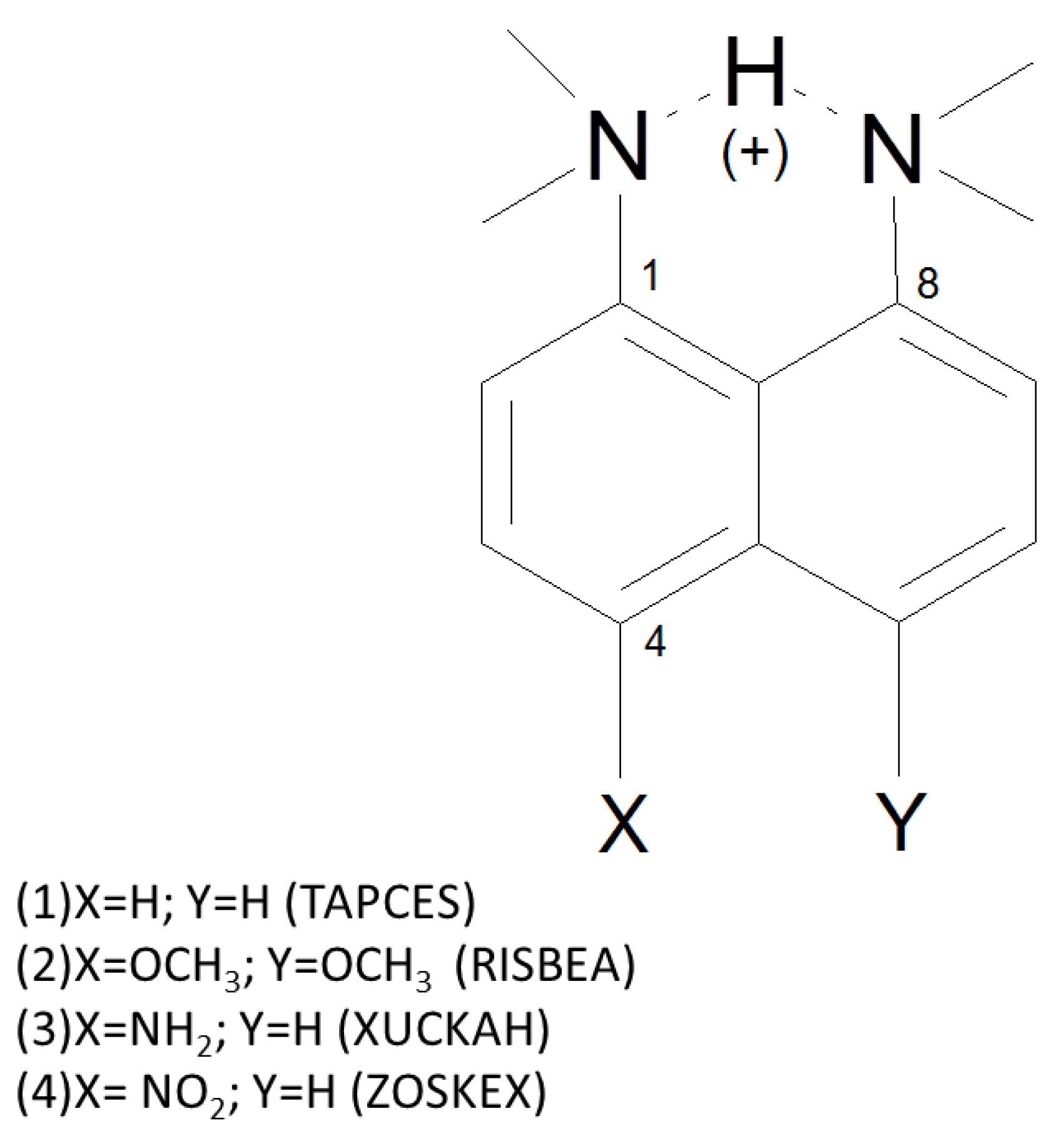
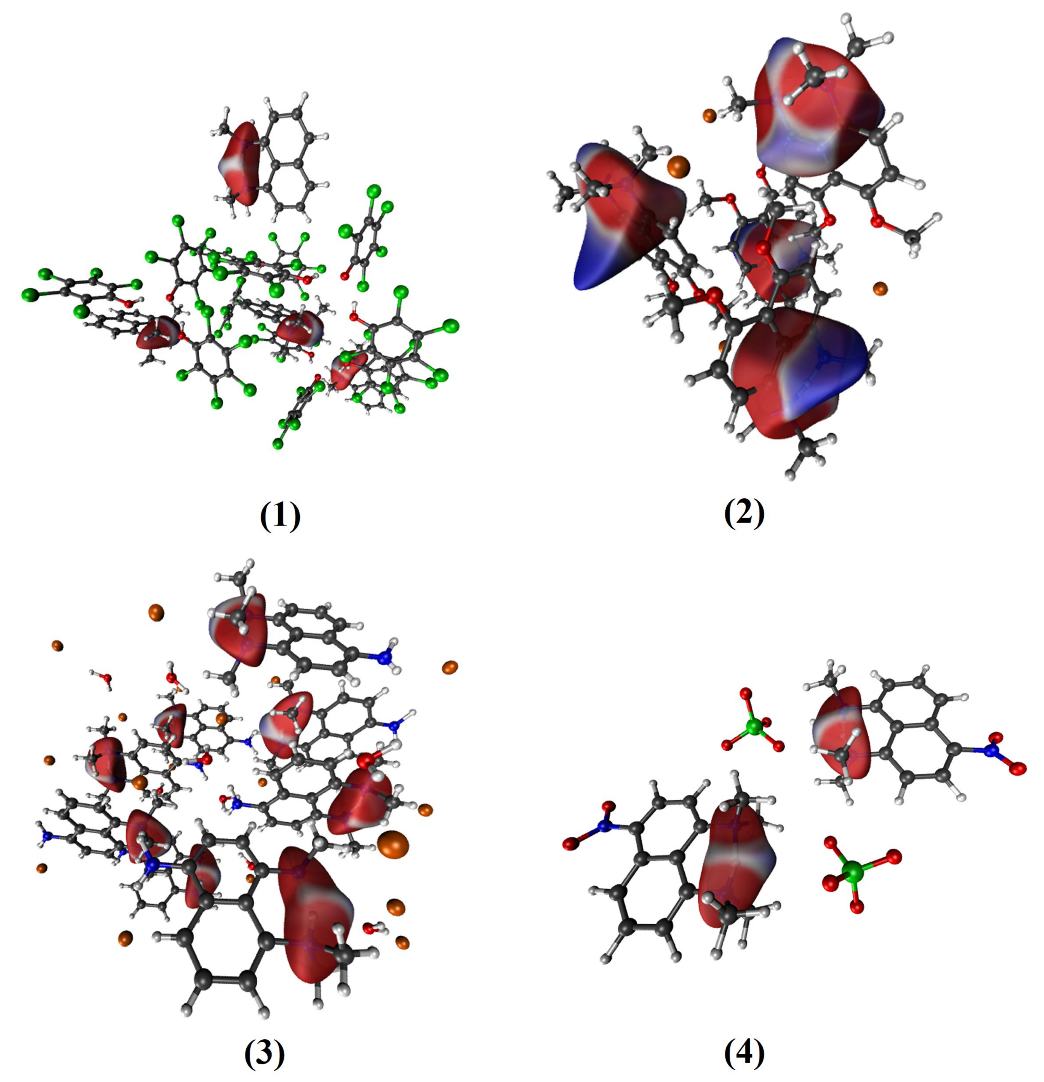
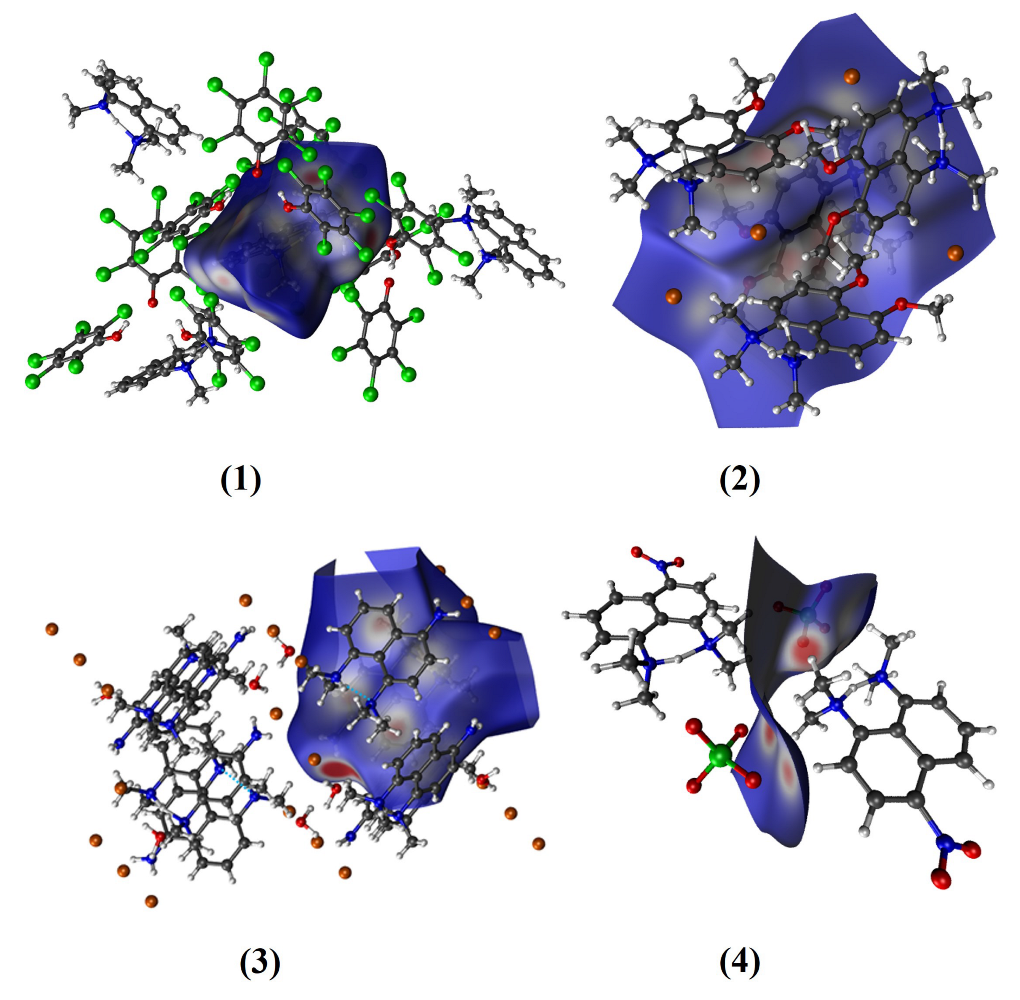
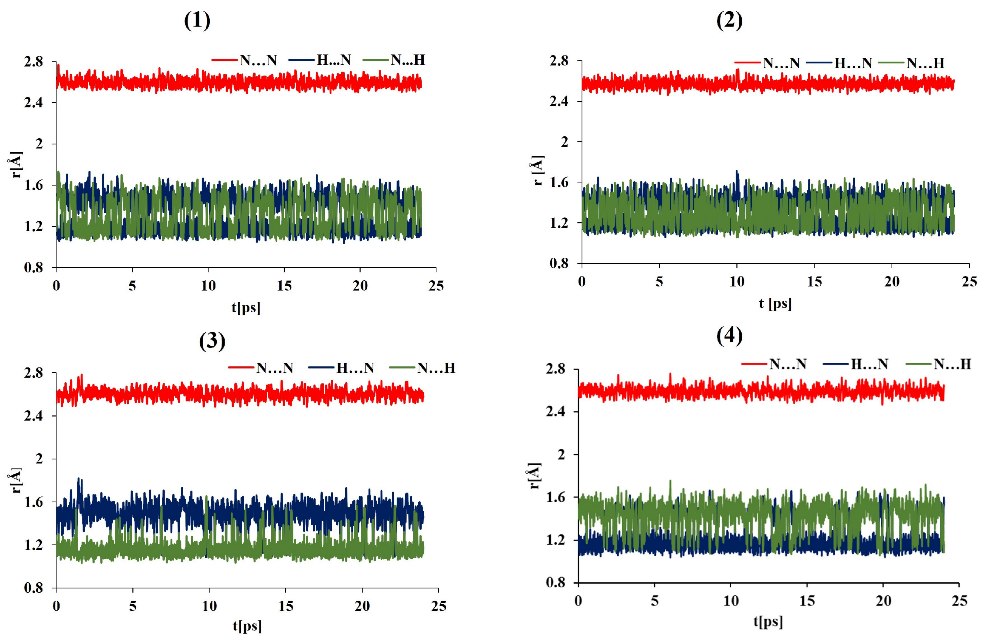
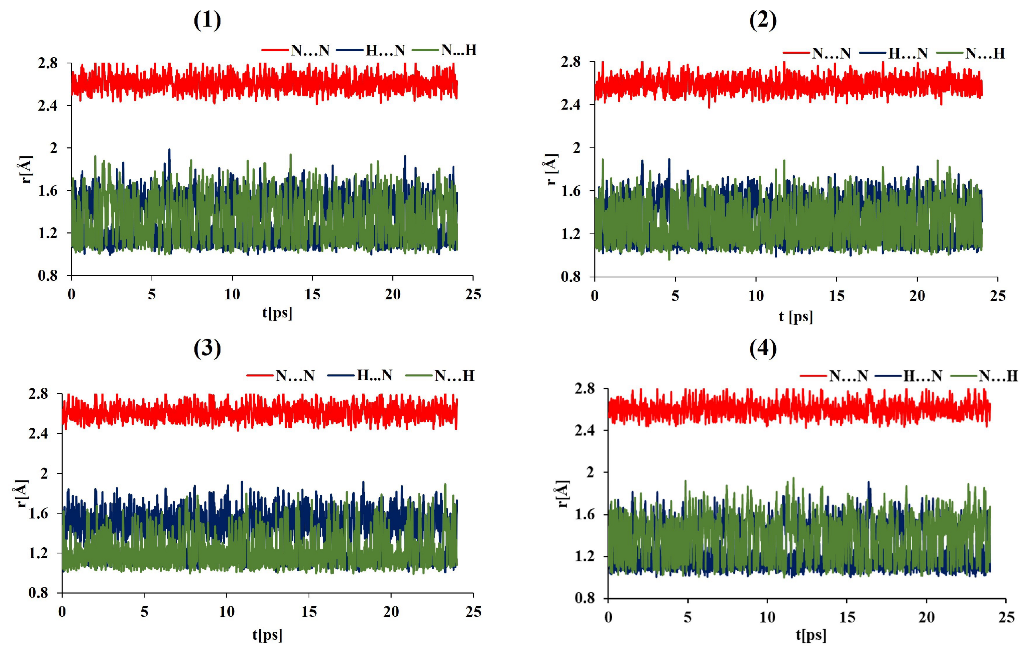

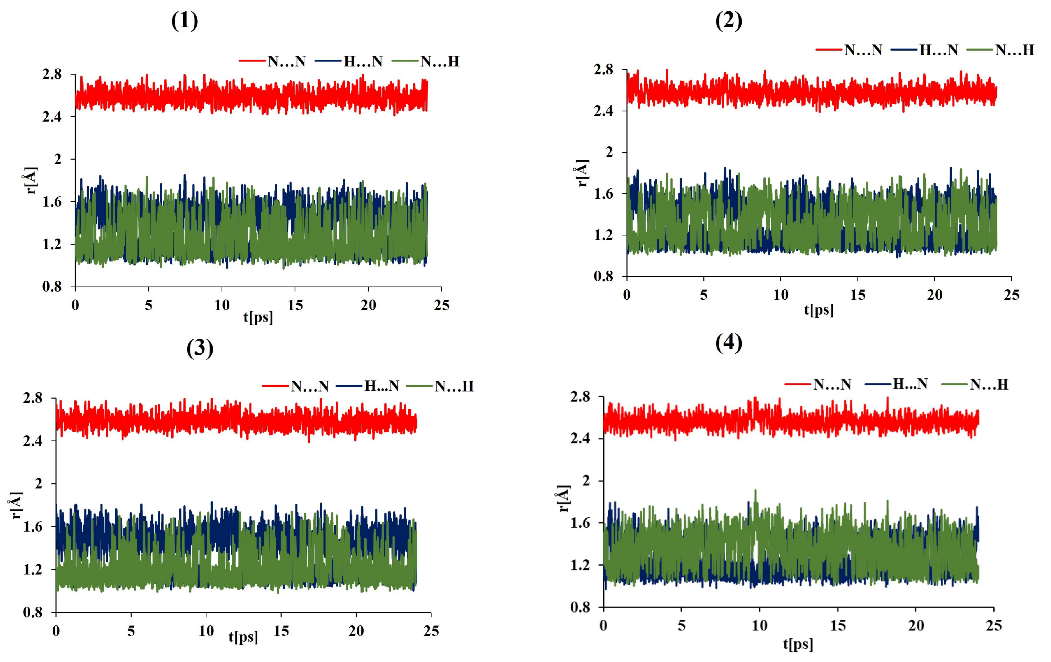

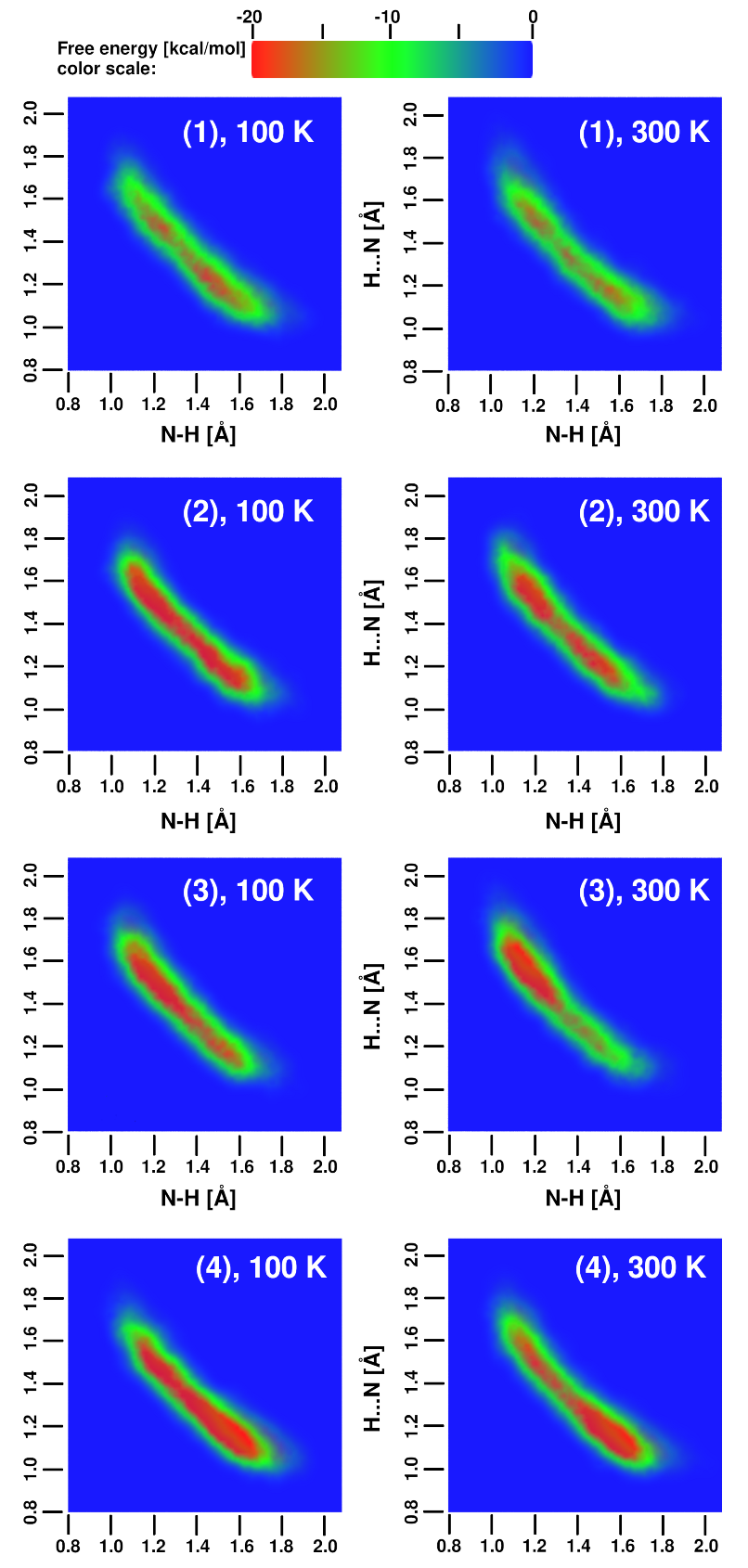
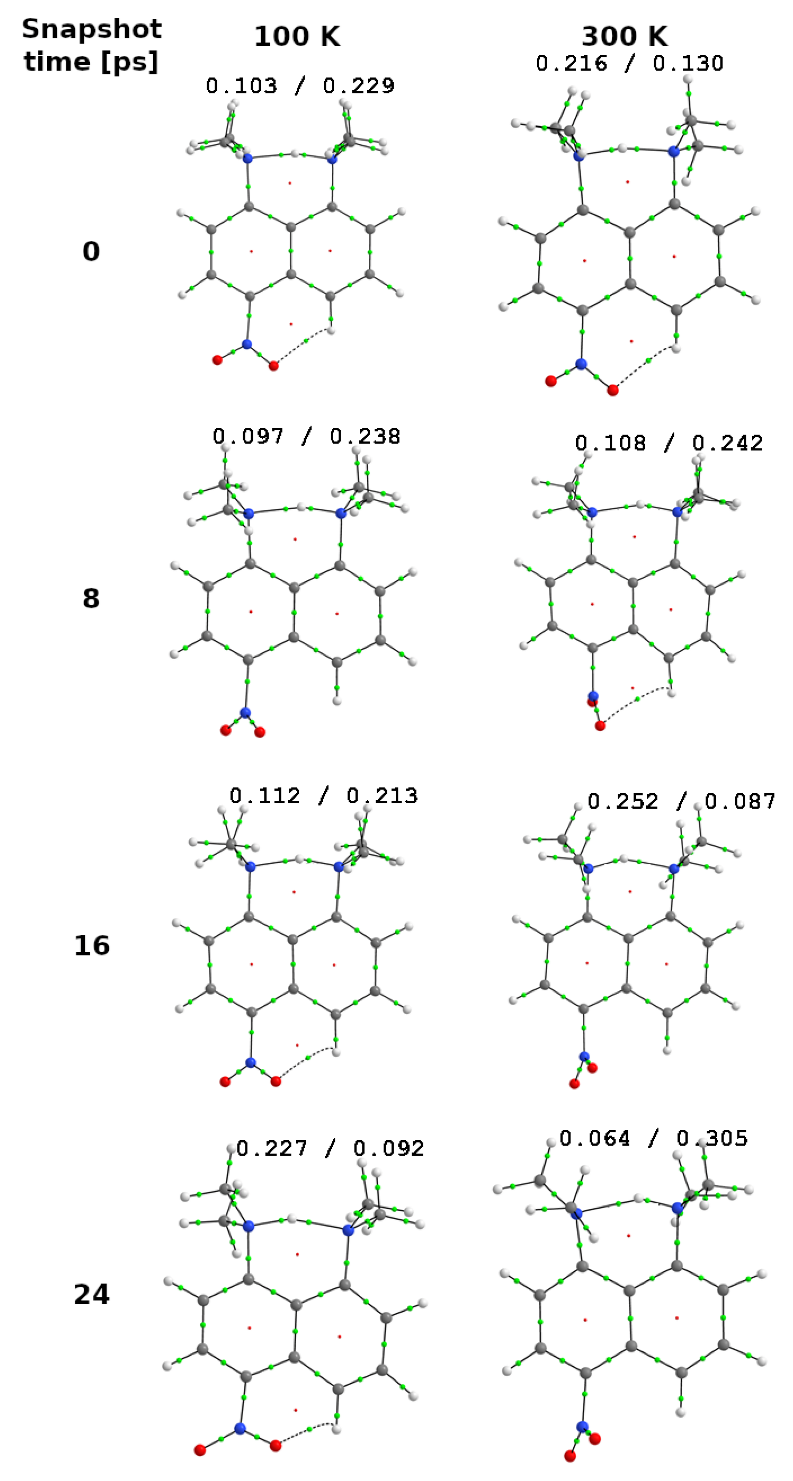
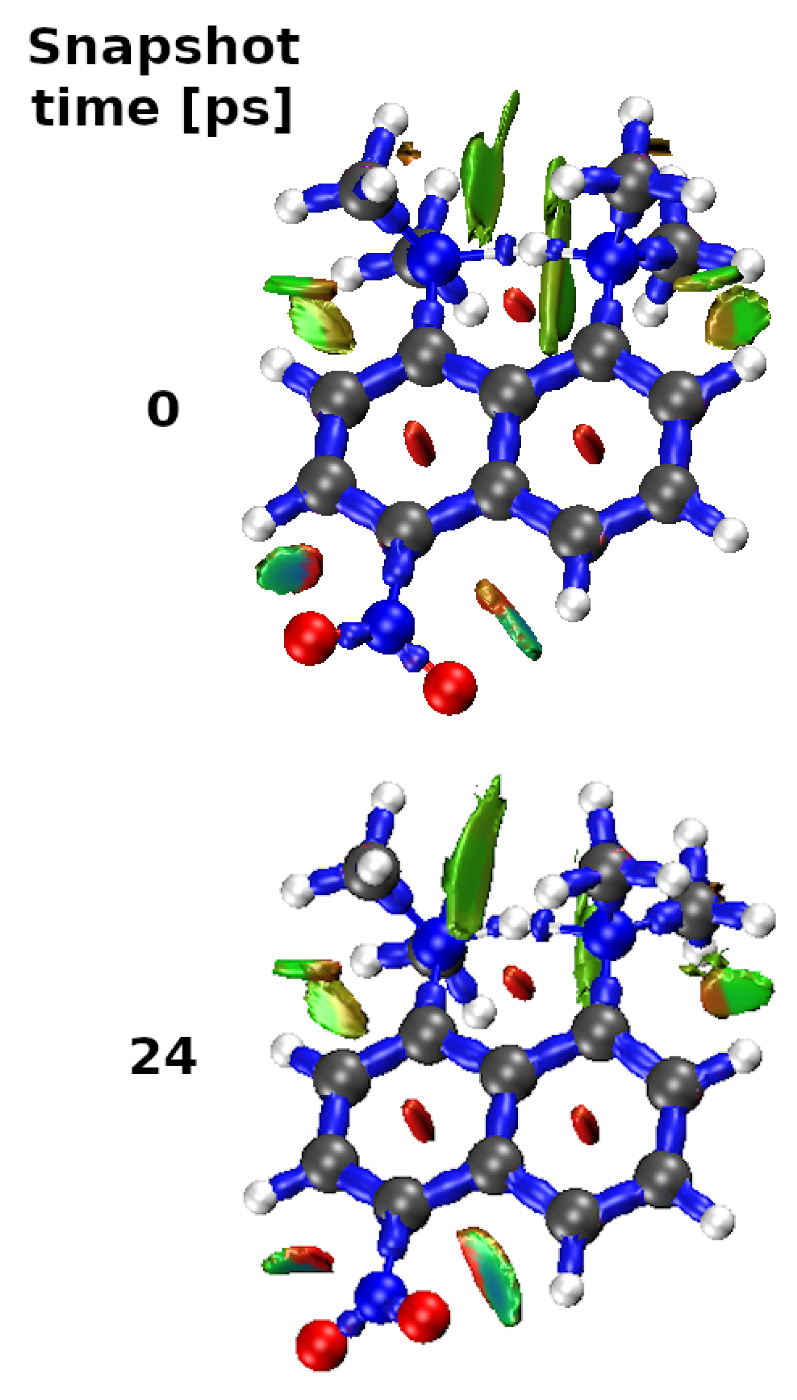
| Compound | Contact | ||||
|---|---|---|---|---|---|
| O⋯H | Cl⋯H | C⋯H | H⋯Br | C-H⋯π | |
| (1) | + | + | − | − | − |
| (2) | + | − | + | − | + |
| (3) | + | − | + | + | + |
| (4) | + | − | − | − | − |
| Compound | Proton Possession (%) | |||
|---|---|---|---|---|
| Gas Phase | Crystalline Phase | |||
| 100 K | 300 K | 100 K | 300 K | |
| (1) | 50.2 | 48.9 | 84.4 | 60.8 |
| (2) | 51.8 | 50.8 | 29.7 | 48.4 |
| (3) | 91.5 | 74.2 | 55.4 | 72.5 |
| (4) | 18.3 | 37.8 | 10.9 | 36.8 |
| Number | CCDC Code and Number | Unit Cell Data | Ref. |
|---|---|---|---|
| 1 | TAPCES (1266338) | orthorhombic, a = 11.363 Å, b = 16.676 Å, | [47] |
| c = 20.307 Å, Z = 4 | |||
| 2 | RISBEA (122006) | tetragonal, a = 11.410 Å, b = 11.410 Å, | [48] |
| c = 13.126 Å, Z = 4 | |||
| 3 | XUCKAH (170012) | monoclinic, a = 11.182 Å, b = 14.236 Å, | [49] |
| c = 19.935 Å, Z = 8 | |||
| 4 | ZOSKEX (1315231) | triclinic, a= 7.986 Å, b = 12.463 Å, | [50] |
| c = 8.663 Å, Z = 2 |
Disclaimer/Publisher’s Note: The statements, opinions and data contained in all publications are solely those of the individual author(s) and contributor(s) and not of MDPI and/or the editor(s). MDPI and/or the editor(s) disclaim responsibility for any injury to people or property resulting from any ideas, methods, instructions or products referred to in the content. |
© 2023 by the authors. Licensee MDPI, Basel, Switzerland. This article is an open access article distributed under the terms and conditions of the Creative Commons Attribution (CC BY) license (https://creativecommons.org/licenses/by/4.0/).
Share and Cite
Kizior, B.; Michalczyk, M.; Panek, J.J.; Zierkiewicz, W.; Jezierska, A. Unraveling the Nature of Hydrogen Bonds of “Proton Sponges” Based on Car-Parrinello and Metadynamics Approaches. Int. J. Mol. Sci. 2023, 24, 1542. https://doi.org/10.3390/ijms24021542
Kizior B, Michalczyk M, Panek JJ, Zierkiewicz W, Jezierska A. Unraveling the Nature of Hydrogen Bonds of “Proton Sponges” Based on Car-Parrinello and Metadynamics Approaches. International Journal of Molecular Sciences. 2023; 24(2):1542. https://doi.org/10.3390/ijms24021542
Chicago/Turabian StyleKizior, Beata, Mariusz Michalczyk, Jarosław J. Panek, Wiktor Zierkiewicz, and Aneta Jezierska. 2023. "Unraveling the Nature of Hydrogen Bonds of “Proton Sponges” Based on Car-Parrinello and Metadynamics Approaches" International Journal of Molecular Sciences 24, no. 2: 1542. https://doi.org/10.3390/ijms24021542
APA StyleKizior, B., Michalczyk, M., Panek, J. J., Zierkiewicz, W., & Jezierska, A. (2023). Unraveling the Nature of Hydrogen Bonds of “Proton Sponges” Based on Car-Parrinello and Metadynamics Approaches. International Journal of Molecular Sciences, 24(2), 1542. https://doi.org/10.3390/ijms24021542







